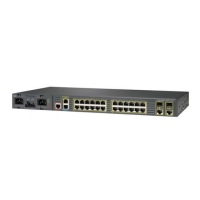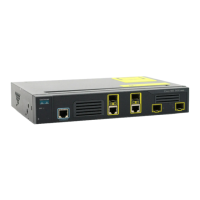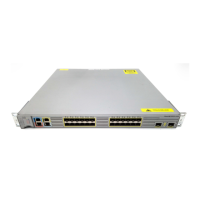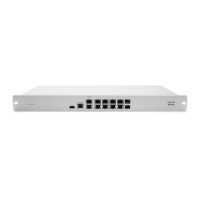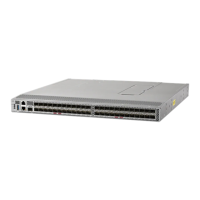2-24
Cisco ME 3400 Ethernet Access Switch Hardware Installation Guide
OL-7677-01
Chapter 2 Switch Installation
Connecting to SFP Modules
Step 4 Observe the port status LED.
The LED turns green when the switch and the target device have an established link.
The LED turns amber while the STP discovers the network topology and searches for loops. This process
takes about 30 seconds, and then the port LED turns green.
If the LED is off, the target device might not be turned on, there might be a cable problem, or there might
be problem with the adapter installed in the target device. See Chapter 3, “Troubleshooting,” for
solutions to cabling problems.
Step 5 If necessary, reconfigure and restart the switch or target device.
Connecting to 1000BASE-T SFP Modules
Follow these steps to connect a Category 5 cable to a 1000BASE-T SFP module (see Figure 2-26):
Figure 2-26 Connecting to a 1000BASE-T SFP Module
Caution To prevent ESD damage, follow your normal board and component handling procedures.
Step 1 When connecting to servers, workstations, and routers, insert a four twisted-pair, straight-through
cable in the RJ-45 connector. When connecting to switches or repeaters, insert a four twisted-pair,
crossover cable.
Note When connecting to a 1000BASE-T device, be sure to use a four twisted-pair, Category 5 cable.
Note You can use the mdix auto interface configuration command in the CLI to enable the automatic
medium-dependent interface crossover (auto-MDIX) feature. When the auto-MDIX feature is enabled,
the switch detects the required cable type for copper Ethernet connections and configures the interfaces
accordingly. Therefore, you can use either a crossover or a straight-through cable for connections to a
copper 10/100 or 1000BASE-T SFP module port on the switch, regardless of the type of device on the
other end of the connection.
Step 2 Insert the other cable end in an RJ-45 connector on a target device.
1 RJ-45 connector
C
isco M
E
3400
S
E
R
IE
S
1
2
132680
1
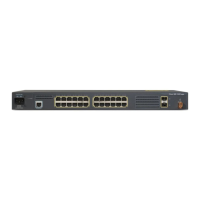
